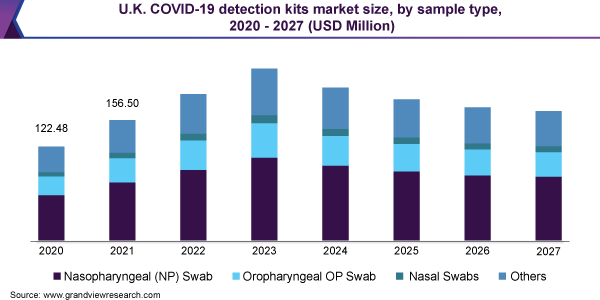COVID-19 Detection Kits Industry Overview
The global COVID-19 detection kits market size is expected to reach USD 4.63 billion by 2027, according to a new report by Grand View Research, Inc. It is projected to register a CAGR of 5.05% during the forecast period. The COVID-19 pandemic has posed several challenges to the global healthcare systems. The diagnostics area is recognized as one of the primary elements of efforts to contain the spread and circumvent its adverse impact globally. As a result, companies are ramping up their production process to meet the demand or kits and reagents as well as at-home tests, thereby driving the market revenue.

Constantly increasing demand for rapid diagnostic tests that can deliver results in less time coupled with a shortage of testing materials has triggered the development of antibody and antigen test kits. For instance, in August 2020, Abbott Laboratories secured approval for a COVID-19 portable antigen test that can deliver results in 15 minutes.
COVID-19 Detection Kits Market Segmentation
Grand View Research has segmented the global COVID-19 detection kits market on the basis of product, sample type, mode, end-use, and region:
Based on the Products Insights, the market is segmented into RT-PCR Assay Kits and Immunoassay Test Strips/Cassettes
- RT-PCR assay kits are estimated to account for the maximum revenue share of 67% in 2020.
- Immunoassays test strips are promising tools for the first-line diagnosis of COVID-19 during the ascendant phase of the pandemic and are anticipated to register the fastest growth rate.
Based on the Sample Type Insights, the market is segmented into Nasopharyngeal (NP) Swab, Oropharyngeal (OP) Swab, Nasal Swab, and Others
- Nasopharyngeal swabs (NP) are estimated to dominate the revenue share with more than 45% in 2020 owing to the high usage of NP swabs for molecular testing.
- Ongoing large scale geographic seroprevalence surveys to estimate the number of people infected with the SARS-CoV-2 but were not included in official case counts; boost the revenue growth in this segment.
Based on the Mode Insights, the market is segmented into Decentralized or Point-of-Care (PoC) Testing and Centralized Testing (Non-PoC)
- Detection kits for centralized or laboratory testing are currently dominating the COVID-19 detection kits market with a revenue share of around 68% in 2020.
- POC testing, such as rapid antigen tests, is relatively less reliable in terms of result accuracy owing to their low sensitivity.
Based on the End-use Insights, the market is segmented into Laboratories, Hospitals, Diagnostic Centers and Clinics, and Others (Research Institutes & Direct-to-Consumers)
- The laboratories segment is projected to account for a revenue share of 40% in 2020, resulting in its dominance over other counterpart segments.
- Diagnostic centers and clinics are projected to grow at the fastest CAGR during the forecast period due to numerous efforts undertaken by several entities.
COVID-19 Detection Kits Regional Outlook
- North America
- Europe
- Asia Pacific
- Latin America
- Middle East & Africa (MEA)
Key Companies Profile & Market Share Insights
Market participants are incessantly developing several types of kits for the detection of SARS-CoV-2 infection across the globe. Such new product development initiatives along with partnership and collaboration models, agreements, business expansion, and merger and acquisition strategies are undertaken by the company as a response to the rising demand for COVID-19 test capabilities globally. This is expected to intensify the competition among key participants in future market space.
Some prominent players in the global COVID-19 Detection Kits market include:
- Hoffman-La Roche Ltd.
- Thermo Fisher Scientific, Inc.
- Perkin Elmer, Inc.
- Veredus Laboratories
- DiaSorin
- altona Diagnostics GmbH
- Mylab Discovery Solutions Pvt Ltd
- Abbott
- Luminex Corporation
- Quidel Corporation
- Becton, Dickinson and Company
Order a free sample PDF of the COVID-19 Detection Kits Market Intelligence Study, published by Grand View Research.


No comments:
Post a Comment